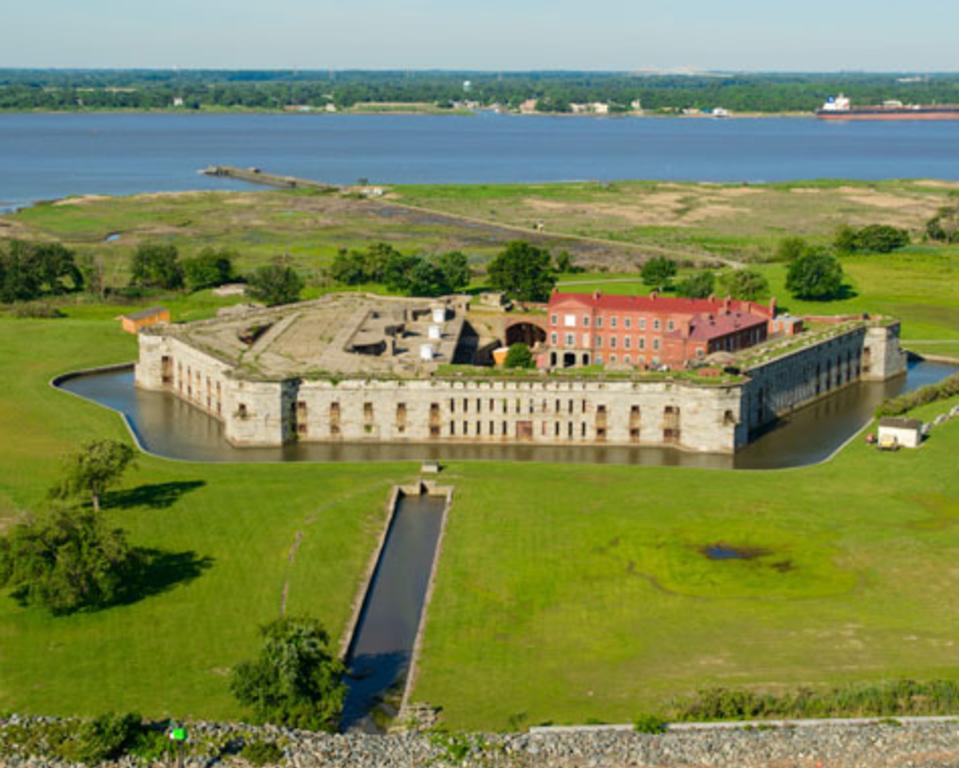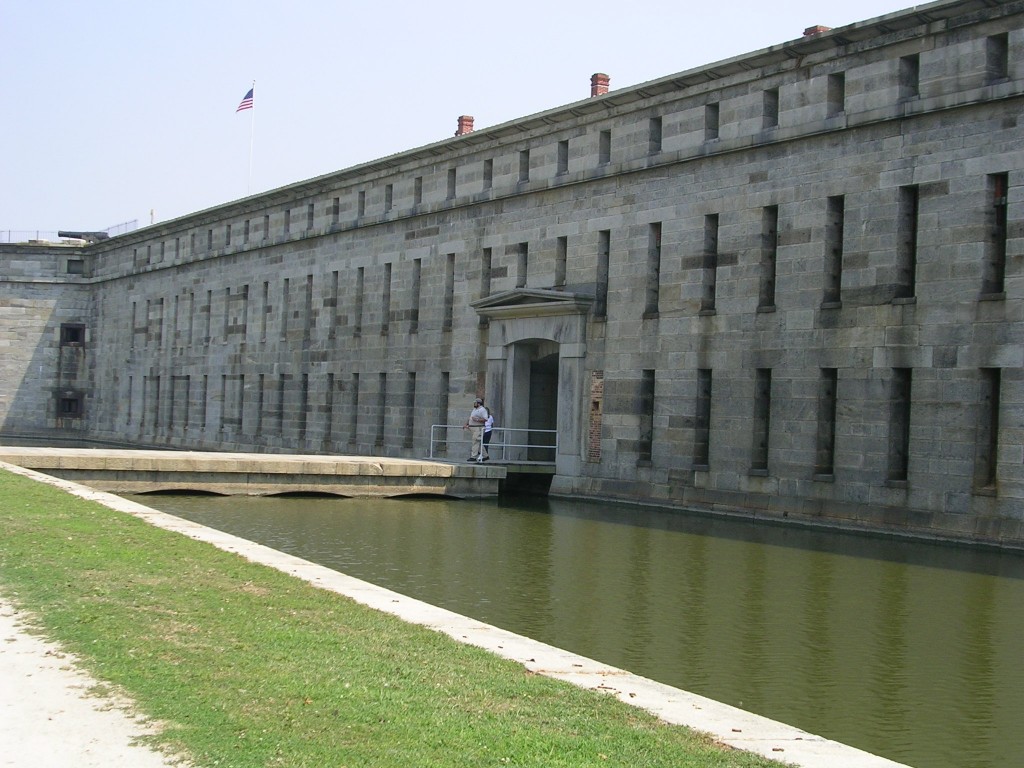
Fort Delaware: Where History Whispers Through Granite and Ghostly Echoes
The Delaware River, a silent artery of commerce and history, often hides its secrets in plain sight. But for those who venture just a short ferry ride from the quaint shores of Delaware City, a formidable sentinel rises from the placid waters: Fort Delaware. Nestled on Pea Patch Island, this colossal granite bastion, shaped like a five-pointed star, stands as a stark reminder of a pivotal era in American history. More than just a fortress, Fort Delaware is a time capsule, a place where the echoes of Civil War cannon fire, the clanking of prison chains, and the whispers of long-departed souls seem to cling to its cold, hard walls.
From the moment the Fort Delaware Express ferry cuts through the gentle current, leaving the modern world behind, the journey becomes an immersion. The island, shrouded in mist on an early morning, or bathed in the golden glow of a late afternoon sun, gradually reveals its impressive occupant. This isn’t just a historical site; it’s an experience, a living, breathing testament to sacrifice, strategic genius, and the complex human drama of conflict.
A Strategic Bastion: The Gibraltar of the Delaware

The story of Fort Delaware begins long before the Civil War, rooted in the strategic importance of the Delaware River. As early as the War of 1812, the vulnerability of Philadelphia, a vital American port and industrial center, became acutely clear. Following this conflict, the United States embarked on an ambitious program known as the "Third System of Fortifications," a nationwide effort to protect its vulnerable coastlines. Pea Patch Island, a low-lying marshy outcrop in the middle of the river, proved to be the ideal choke point.
The first attempts at fortification on the island were plagued by engineering challenges, with early structures succumbing to the soft, unstable ground. However, under the brilliant design of Chief Engineer Joseph G. Totten, work on the current granite fort began in 1848. Totten envisioned an impregnable fortress, a "Gibraltar of the Delaware," capable of repelling any naval assault. Built primarily by Irish immigrants and free African American laborers, the fort’s construction was a monumental undertaking. Thousands of granite blocks, quarried in Maine, were transported by ship and meticulously placed, creating walls up to 30 feet thick in places. The fort’s star shape, a hallmark of 17th and 18th-century military architecture, was not merely aesthetic; it provided overlapping fields of fire, eliminating blind spots and maximizing defensive capabilities.
By 1860, as the nation teetered on the brink of civil war, Fort Delaware was nearing completion, bristling with an array of powerful Rodman and Columbiad cannons. Its primary purpose was to guard the crucial maritime approaches to Philadelphia and Wilmington, ensuring the Union’s access to vital industrial capacity and supply lines. No enemy ship ever dared to test its might. However, destiny had a far different, and darker, role in store for this formidable sentinel.
From Fortress to Prison: The Civil War’s Unintended Consequence
With the outbreak of the Civil War in April 1861, Fort Delaware’s role swiftly transformed. While its coastal defense capabilities remained paramount, the immediate need was for a secure location to house captured Confederate soldiers. The first prisoners arrived in July 1861, primarily Confederate officers and political prisoners deemed a threat to the Union. Among these early arrivals were prominent figures like Brigadier General Isaac R. Trimble, who would later lose a leg at Gettysburg.
Initially, conditions were relatively humane, reflecting the fort’s original design as military barracks. However, as the war dragged on and the number of prisoners surged, particularly after major Union victories like Gettysburg and Vicksburg, the fort quickly became overwhelmed. What began as a holding facility for a few hundred quickly escalated into a massive prisoner-of-war camp, housing over 12,500 men at its peak in 1863. Over 33,000 Confederate soldiers would pass through its gates during the war.
The granite walls, once a symbol of protection, now became a cage. To accommodate the influx of enlisted men, a sprawling complex of wooden barracks, known as "the pens," was hastily constructed in the parade ground. The sheer numbers, coupled with inadequate sanitation, limited medical care, and often insufficient rations, led to dire conditions. Diseases such as scurvy, smallpox, typhoid, and dysentery ran rampant, claiming thousands of lives. The swampy nature of Pea Patch Island, with its notorious mosquito population, only exacerbated the suffering.
Life (and Death) Behind Bars

Life for the Confederate prisoners at Fort Delaware was a harsh reality of deprivation and boredom, punctuated by moments of despair and flickering hope. Accounts from both prisoners and Union guards paint a grim picture. Food, while generally adequate in the early years, deteriorated in quality and quantity as the war progressed, mirroring conditions in Southern prisons. Many prisoners supplemented their meager diets by fishing, bartering with guards, or even catching rats.
Escape attempts, though often futile, were a constant feature. Prisoners dug tunnels, attempted to swim the treacherous currents of the Delaware River, or tried to bribe guards. One particularly daring attempt involved a group of prisoners digging a tunnel from their barracks, only to emerge directly into the fort commander’s kitchen, leading to their swift recapture.
The human element of the fort extended beyond the prisoners. Union guards, often raw recruits or veteran soldiers deemed unfit for active combat, maintained constant vigilance. Notably, a significant number of U.S. Colored Troops (USCT) served as guards at Fort Delaware, particularly in the later years of the war. For these African American soldiers, many of whom were formerly enslaved, guarding Confederate soldiers represented a profound reversal of fortune and a powerful statement about their newfound freedom and agency. Their presence often sparked resentment and defiance among the white Confederate prisoners, leading to tense interactions.
The death toll at Fort Delaware was staggering. By the end of the war, an estimated 2,700 Confederate prisoners, along with some Union guards and civilians, had perished on Pea Patch Island. They were buried in a national cemetery on the mainland in Finn’s Point, New Jersey, a stark testament to the human cost of the conflict, even far from the battlefields.
Post-War Decline and Modern Rebirth
After the surrender at Appomattox in April 1865, the last Confederate prisoners were released from Fort Delaware. The fort, having served its unexpected role, slowly faded from national prominence. For a brief period during the Spanish-American War in 1898, it saw a minor revitalization, with new concrete batteries added to house more modern weaponry. However, the age of masonry forts was drawing to a close. Advances in artillery technology rendered such fixed defenses increasingly obsolete. By the early 20th century, Fort Delaware was largely abandoned by the military, its grand granite walls falling into disrepair, its history slowly being reclaimed by nature.
It wasn’t until the mid-20th century that the fort’s unique historical significance was recognized. In 1951, the State of Delaware acquired Pea Patch Island and the fort, embarking on a long and meticulous journey of preservation and restoration. Today, Fort Delaware State Park is a jewel in Delaware’s crown, a testament to dedicated historians, preservationists, and volunteers.
Experiencing the Past: Living History and Lingering Spirits
A visit to Fort Delaware today is far more than a walk through ruins. It is a vibrant, immersive journey back in time, largely due to its acclaimed living history program. Costumed interpreters, meticulously researched and passionately portrayed, bring the 1864 era to life. Visitors might encounter a stern Union guard, a resourceful Confederate prisoner, a diligent laundress, or a skilled blacksmith. They answer questions, demonstrate daily tasks, and recount stories, blurring the lines between past and present.
"We’re not just telling history here; we’re showing it," explains Sarah Thompson, a long-time park historian, her voice resonating with the passion of someone deeply connected to the fort’s narrative. "You can read about the conditions, but when you see a reenactor in period clothing, struggling with the heat in the barracks, or describing the meager rations, it becomes real. It touches you."
Visitors can explore the fort’s various levels, from the damp, cavernous casemates where cannons once stood ready, to the officers’ quarters, the kitchen, and the prison barracks. The sheer scale of the fort is awe-inspiring, its cold granite walls seeming to absorb the stories of generations. The air itself feels heavy with history, a palpable sense of the thousands of lives that unfolded within these confines.
Beyond the meticulously researched historical interpretations, Fort Delaware also holds a compelling allure for those interested in the paranormal. Given its history of death, disease, and suffering, it’s perhaps unsurprising that the fort has gained a reputation as one of the most haunted locations in the Mid-Atlantic. Numerous accounts of unexplained phenomena—disembodied voices, phantom footsteps, flickering lights, and the eerie feeling of being watched—have been reported by staff, visitors, and professional ghost hunters alike. From the spectral presence of a forlorn female figure in the kitchen to the lingering spirits of Confederate prisoners, the fort’s "otherworldly" residents add another layer of intrigue to its already rich tapestry. Whether one believes in ghosts or not, the fort’s atmosphere certainly lends itself to such tales, making a visit even more evocative.
An Enduring Legacy
Fort Delaware is more than just a well-preserved fort or a popular tourist destination. It is a powerful educational tool, offering invaluable lessons about the Civil War, military engineering, and the resilience of the human spirit. It serves as a somber reminder of the costs of conflict and the often-overlooked suffering of prisoners of war.
As the ferry pulls away from Pea Patch Island at the end of the day, carrying visitors back to the modern world, the fort gradually recedes into the horizon. Yet, its imposing silhouette, carved against the setting sun, leaves an indelible impression. Fort Delaware stands as a silent witness to a tumultuous chapter in American history, its granite walls forever echoing the whispers of the past, inviting all who visit to listen closely and remember. It is a place where history isn’t just observed; it is deeply, profoundly felt.


